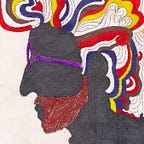A Child’s Light
The goal of this series, A Child’s Physics, is to show how to draw the child’s awareness to different types of energy and to the eventual realization that the core of human technology is the act of transforming energy from one type to another. Light is particularly interesting, in that sense, because as much as we are surrounded by it, we don’t focus on the light itself. We first see the objects that reflect it. Even when looking directly into a light source, it is the source object that tends to be perceived. At a stop light you don’t see red light, you see the red light. Light is illusive. We cannot see the light just below and above what we call the visible spectrum. What we cannot see can warm us, control our devices and change our skin.
Light appears spontaneously in shafts, explosions and beams through scattering, direct line of sight and play of shadows.
Light also appears, in and of itself, as a spectrum.
Light can be realized through its absence.
There is a vast spectrum of light we cannot see.
Animals and insects see other parts of it.
There are a number of very instructive and affordable light sources, all hand held and battery powered.
There are many interesting things to shine light on and through, namely, lenses, filters ( polarizing, colored, ir/uv, diffraction), mirrors (plane, spherical, parabolic), fibers, water, sits and pinholes, reactive materials, meters, cameras. Filters, cameras and meters are direct Sensory Enhancements. The links throughout this article are to help begin searching for these materials.
Given a simple set of sources and objects, a number of experiences concerning Light can be made concrete. This is done simply by demonstrating the use of the objects and sources, playing with them, and talking about them. Phenomenon, action, language, concept.
Beginning in the primary environment, we can teach the following ideas :
A lens bends light.
A mirror bounces light.
A fiber guides light.
A filter absorbs light.
Openings create patterns.
Minerals absorb and radiate Light
Electricity can be transformed into Light.
Light can be transformed into Electricity.
Light can be transformed into heat.
Light can be transformed into living tissue.
Light spreads into a spectrum
Light can be mixed.
Light can be invisible.
Light can be coherent or diffuse.
Light behaves as both a wave and a particle.
Light can go through solid objects.
Light creates images.
Light can be measured.
Light can be coded.
Light can be given meaning.
Light has a three part equation.
Light has speed.
A lens bends light.
A mirror bounces light.
A fiber guides light.
A filter absorbs light.
Openings create patterns.
Minerals absorb and radiate Light.
Light can be converted into Electricity.
Electricity can be converted into light.
Light can be converted into heat.
Light becomes living tissue.
Light spreads into a visible spectrum.
Light can be mixed.
There is more light than is visible.
Light can be coherent or diffuse.
Light behaves as both a wave and a particle.
Light can pass through solid objects.
Light can create images.
Light can be measured.
Light can be coded.
Light can be given meaning.
Light has a Three Part Equation.
And so,
Light moves. Light has speed, a specific speed.
These are all things we all know now. Remember not knowing. That is the child’s reality. These ideas are important because Light, and the way we experience it, have a profound personal and cultural effects.
A Child’s Light is one of a series of articles presenting Physics at a primary level.
